Evaluation of the readability of road signs and roadside elements using Mobile Eye tracking device
DOI:
https://doi.org/10.6092/issn.2036-1602/5058Keywords:
eye-tracking, road signs, road safety, eye movementsAbstract
Vertical signs shall be located on the road according to a proper signalling plan, capable of providing relevant information to drivers in a harmonious, integrated and effective way. To achieve these targets, it is essential to investigate how road users look and perceive vertical signs while driving. For this purpose, an experimental research project was carried out onsite which involved 22 road users, driving on a road stretch comprising different types of vertical signs. By the use of an innovative eye-tracking device, capable of tracking human eye and its movements, it was possible to continuously record the glance aiming point of each road user, obtaining a detailed analysis of driver/ vertical signs interaction.References
Bucchi A., Sangiorgi C., & Vignali V. (2012). “Traffic psychology and driver behaviour”, in Procedia - Social and Behavioral Sciences, 53, 973-980.
Borowsky A., Shinar D., & Parmet Y. (2008) “The relation between driving experience and recognition of road signs relative to their locations”, in Human Factors, 50, 173-182.
Inman V. W. (2012) “Conspicuity of traffic signs assessed by eye tracking and immediate recall”, in proceedings of the Human Factors and Ergonomics Society, 56th Annual Meeting (pp. 2251{2255). Human Factors and Ergonomics Society.
Johansson G., & Backlund F. (1970) “Drivers and road signs”, in Ergonomics, 13, 749-759.
Downloads
Published
How to Cite
Issue
Section
License
Copyright (c) 2014 Francesco Mazzotta, Valeria Vignali, Federico Irali
Copyrights and publishing rights of all the texts on this journal belong to the respective authors without restrictions.
This journal is licensed under a Creative Commons Attribution-NonCommercial 4.0 International License (full legal code).
See also our Open Access Policy.
Metadata
All the metadata of the published material is released in the public domain and may be used by anyone free of charge. This includes references.
Metadata — including references — may be re-used in any medium without prior permission for both not-for-profit and for-profit purposes. We kindly ask users to provide a link to the original metadata record.







